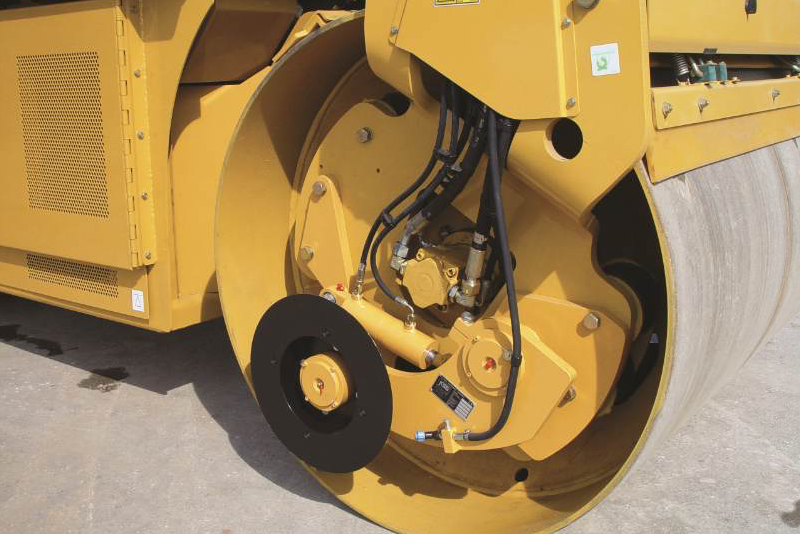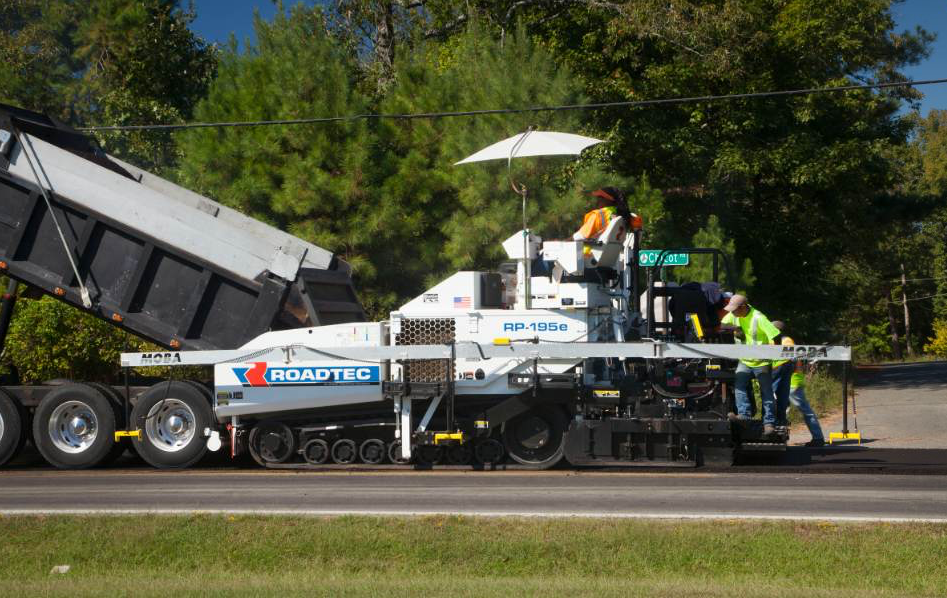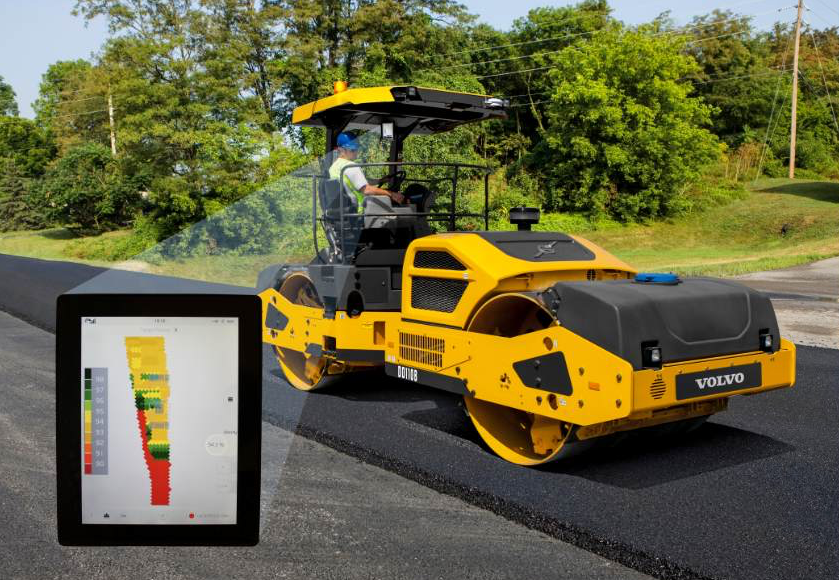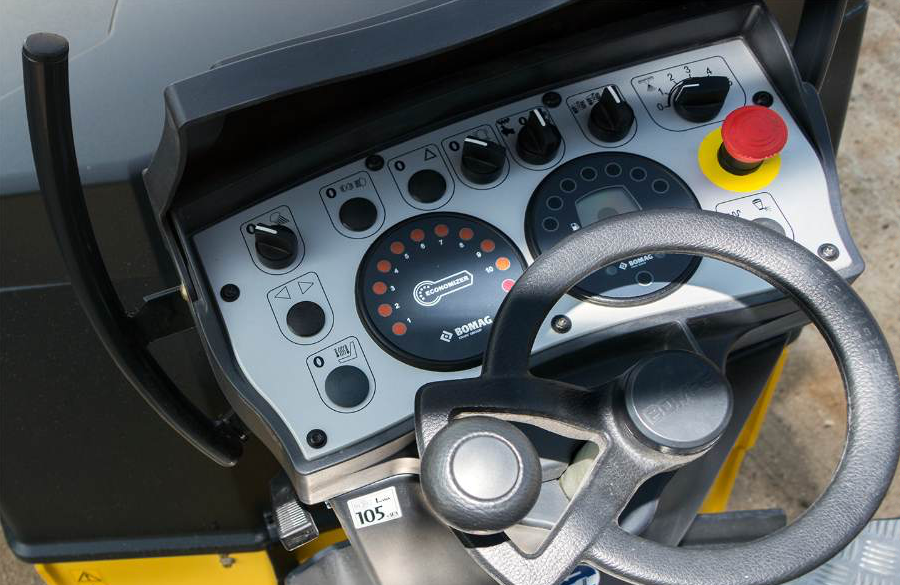Make U.S. Mats Better
BY Sandy Lender

Author’s Note: Many articles discussing intelligent compaction systems have taken up page-space in trade publications during the past few years. This article will delve into exactly how the systems can help your roller operator achieve desired density.
Let me begin this discussion of intelligent compaction (IC) by reminding contractors we have an article about training in this edition of AsphaltPro because a quality mat comes down to the capabilities of the crew. If the members of the crew are complacent in the use of technology designed to assist in achieving compaction and in the upkeep of the equipment, then the project is probably doomed. But if the members of the crew are invested in the company’s positive future, the end product for the end user has a greater chance for long-lasting success.

First, remember that not all IC systems communicate with the roller operator in the same manner. Obviously, there will be a learning curve no matter which system your crew uses. The first thing you have to teach the roller operator is what the IC system will do and what it won’t do toward achieving compaction of the asphalt mat. Chris Connolly is the director, national accounts and dealer development for Roadtec, Inc., of Chattanooga. While the company doesn’t manufacture rollers, Connolly began working in earnest with the Federal Highway Administration on the IC concept in 1998 when in the employ of a compaction equipment company. His considerable experience with asphalt rolling patterns and practices brought some truths to light for this discussion.
“The optimum time for compaction is when you have the optimum temperature,” Connolly reminded readers. “With asphalt compaction, you’re looking for particle re-arrangement. Gravity then pulls it all into place.” That re-arrangement takes place when the material is at its best temperature and viscosity.

Target Density
Optimally, the mat immediately behind the screed would have 88 percent of the density a project requires, Connolly shared. This goes back to our original thought; aptitude and attitude are vital to success. The paver operator and his use of automation play a role in achieving a high percentage of density prior to the breakdown roller’s first pass. If the contract for a project requires 94 percent density, then the compaction train needs only to achieve that last 6 percent. “If you get 88 percent off the screed, you need to get 6 percent air voids out,” Connolly said. “The biggest bite of that 6 percent is coming out during breakdown rolling.”
Before we show how to get that last 6 percent, let’s talk about the first 88. It might be a lofty goal to hit with the vibratory screeds of North American paving. When the mantra is “more tons” and foremen race the paver to keep up with a line of haul trucks out of the plant, the heavy or tamping bar screeds of Europe won’t work out on a large scale here. The United States encompasses a large geographic area; our contractors don’t have oodles of time for meticulous paving along a 2-mile stretch of road when another 22-mile stretch is waiting.
Brodie Hutchins, vice president of dealer development of Wirtgen America, Antioch, Tennessee, shared that we could do better than 88 percent if we used the right equipment. “It is very common to get 90 percent plus density behind the screed with the tamping/pressure bar screed designs,” Hutchins said. “North America is one of the few places in the world that uses the rollers for the breakdown process, primarily because we use vibratory-only screeds.”

Tim Kowalski, Hamm applications support manager at Wirtgen America, agreed that in the United States, equipment choices are based on more tons. “The tamping bar, pressure bar screeds that we have can get over 96 percent density,” Kowalski said. “The reason we have a hard time selling them in the U.S. is because you cannot pave as fast with them as the regular vibratory screeds and achieve that kind of density. Here in the U.S. it is about production. How many tons can we get out in a day?”
Kowalski shared what we can do with the status quo. “Most of the time, the compaction behind the screed is more in the upper 70 to low 80 percent compaction range. That being said, if we can be more consistent with our roller passes and stay within a certain temperature range, we would have much more consistent densities across the mat. With more consistent densities comes smoother rides, longer lasting roads, fewer roller passes, which saves in fuel, and more bonus money for the contractor.”
Break it Down
Behind the screed, the breakdown roller of the North American market is the workhorse for getting density. It’s the machine that gets the IC system.
Mark Eckert, the compaction product manager for Volvo Construction Equipment, shared: “Using an IC roller for breakdown makes the most sense. The breakdown roller will achieve more significant air void content reduction because of lower mix viscosity and higher material temperatures.”
While the discussion so far has focused on getting full compaction—achieving a set percent density—Bert Erdmann, product manager of heavy compaction for BOMAG Americas, Inc., reminded contractors that roller operators don’t want to go too far. “IC is a tool to help contractors deliver more accurate results for their customer. It helps to prevent under-compaction and over-compaction. However, the vast majority of asphalt contractors in North America do not require the level of documentation, vectoring drums, GPS, expense and increased level of operator training required by advanced IC systems.”
Erdmann suggested that “entry level” IC systems can help newer operators or those with less training to obtain density and move on to another section of the mat. “This can save companies money and fuel by preventing unnecessary passes, and it saves money by preventing over compaction.”
IC can help prevent the roller operator’s over-compaction of the mat by sending a message to him. What happens is this:
An accelerometer sends information to a processor, which sends information to the operator station. The operator then needs to respond and work according to what he or she sees.
This is a common denominator in IC systems. Systems also tend to include a temperature sensor—or two—that points at the mat to read and send the mat surface temperature to the processor as well. For those systems, the temperature may be factored into the information sent on to the operator station, even though the reading does not indicate the interior mat temperature where air void reduction takes place.
Everyone knows how a temperature sensor works. In simple terms, it’s a thermometer with range.
Let’s look at the accelerometer. This device is typically the size of a box of kitchen matches and is typically placed on the interior frame of the roller’s drum. Connolly explained its function. “The accelerometer measures the stroke of the drum, counting each time the eccentric shaft within the drum turns. It then provides that information to a processor, which does the math.”
The BOMAG Economizer has the accelerometer located in the drum frame area, according to Erdmann. He said it measures the asphalt stiffness. “As the roller makes its series of passes, the material stiffness increases, and a higher number of LED indicator lights illuminate on the operator control panel display.
When the number of lights stops increasing, the optimum level of compaction has been achieved. If the 10 yellow LED indicator lights and the red LED light illuminates, this indicates over-compaction, and provides the operator with immediate feedback to stop compacting this area to prevent over compaction.”
The Economizer offers a mat thermometer that is located in the center articulating joint area of the machine.
For the Cat® Compaction Control with Compaction Meter Value (CMV), the accelerometer is mounted to the front drum.
Bryan Downing, global sales and support consultant for Caterpillar Paving Products, Peoria, Illinois, provided written commentary of how the system works. “A simple way to explain what is happening is that the accelerator [sic] measures the ground response to being struck by the vibrating drum. This response is weighed against the degree to which the drum is rebounding from the resistance of the surface material and given a ‘dimensionless’ value, which can be regarded as an indication of the level of stiffness of the material. The reason we say that it is dimensionless is that the value is a result of the variables and factors present at the time of measurement and cannot be correlated to any other set of measurements or scales. In other words, the value is relevant to the particular place and factors it measured, and is not relevant elsewhere.
“It is important to understand that this measurement is a composite measurement; an ‘average’ of the entire volume of material extending to the depth of compaction influence of the compactor, perhaps as deep as a meter and a half. This will include not only the asphalt layers, but potentially much of the base as well—all represented as a single value. It is not simply measuring the asphalt layer.”
Cat Compaction Control with temperature measurement includes two, infrared, air-purged sensors—front and rear. “Depending on the direction of travel,” Downing provided, “the lead sensor measures the surface layer temperature.”
The accelerometer for the Hamm Compaction Quality (HCQ) system from Hamm/Wirtgen America is mounted on the left of the roller’s front drum, in the center of the drive motor and inside the rubber buffers. “This is to not get a false reading of stiffness if it gets dampened by the buffers,” Kowalski said. “The accelerometer measures the reaction of the drum to the material it is compacting. A softer material will mean a slower reaction. A stiffer material with mean a faster reaction and a higher number. This does not mean density.”
Hamm offers a temperature sensor for the front and rear of its asphalt rollers. “This is to give you the hottest reading of the asphalt in the direction you are creating compaction,” Kowalski said.
Eckert shared the Intelligent Compaction with Density DirectTM from Volvo has the accelerometer mounted on the rear drum of the double-drum vibratory compactor. His colleague, Fares Beainy, research engineer in emerging technologies for Volvo, explained how it works for their system: “The accelerometer is providing the vertical acceleration of the roller drum from which the magnitude of the frequency spectrum at a periodic interval is calculated. In simpler text, the accelerometer is providing feedback on the amount of compaction energy that is absorbed or repelled by the asphalt mat.”
The Density Direct has two temperature sensors—front and rear. Eckert explained: “Mat surface temperature is monitored based on the travel direction of the machine.”
With IC systems providing a reading based on mat stiffness to the operator, what happens when the mat cools to the point no more density can be achieved? Connolly explained that the accelerometer will still read the stiffness, giving the operator the idea that adequate compaction has been met, whether it has been met or not. “The accelerometer will stop giving reliable information when the particles can no longer move. It all comes back to temperature and getting on the mat when the mix is malleable and viscous, when you can move the particles.”
Teach Them Well
That brings us full circle: train your personnel. A well-trained roller operator who understands the concepts behind time and temperature is the first step toward successful use of the IC systems available to contractors. Then the tools of technology become a true force to be reckoned with. They provide real-time feedback that the savvy operator puts into play.
Cat’s Downing agreed that IC systems can function well “as a process control tool. These systems provide information to the operator in real time that they would not ordinarily have. This information allows them visualize and react to data in process, resulting in efficiency and uniform work. Operators are able to execute complete coverage and limit over-compaction while performing the work at the proper temperature range.”
Hamm’s Kowalski shared that the systems also provide backup. “Another thing is now you have a permanent record of what was done on the road that you can always go back to if there are any problems.”
With proper training and care, the roller operator can put the IC technology available today into practice for outstanding results. Preventing over-compaction while building up target density numbers gets a helping hand from the system on the breakdown roller, where North American compaction has time and temperature on its side.
